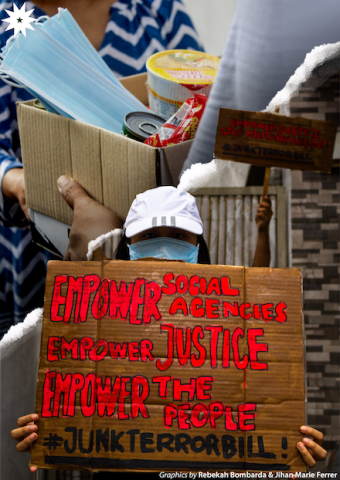
The backdrop of everyday turmoil in the country fans the flames of activism among the Filipino youth. While the ongoing health crisis has put a limit on in-person protests and other physical interactions, it has pushed more people to speak out online.
The activism landscape in organizations such as La Salle Students for Human Rights and Democracy (LS4HRD), formerly known as One La Salle for Human Rights and Democracy, Anakbayan Vito Cruz, and Rise for Education-Taft (R4E-Taft) have changed over the course of the pandemic, with these groups utilizing online platforms more effectively to stay active despite the quarantine restrictions in place.
Experiencing burnout
Numerous areas of an individual’s life can often overlap and merge altogether, leading to an exhaustion of physical or emotional strength over periods of time. This prolonged stress often leads to what many call a burnout, a state where one may feel too overwhelmed to continue work.
Activists who engage in different kinds of social movements are also susceptible to feeling burnt out, and with quarantine limiting interpersonal contact, it has become even more challenging to reach out or interact with colleagues.
R4E-Taft Convener Maeca Camus admits that it is normal to feel burnt out, stressing the importance of finding time to breathe. “Sinusubukan kong maglaan ng araw para sa pahinga kung saan wala akong iisipin kundi ang sarili upang magpalakas para sa hinaharap,” she shares.
(I try to take days off when I can focus on myself and prepare for what lies ahead.)
Aside from the importance of self-care, reminding oneself of why they decided to become an activist can also help boost one’s morale, LS4HRD Convenor Reeya Magtalas says, especially since their work is not an individual struggle but a collaborative effort.
“Hindi ka naman nag-iisa dahil andyan ang kolektib,” she emphasizes. “Kasama mo ang malawak na hanay ng masang Pilipinong walang kapagurang lumalaban.”
(You are not alone when you have the collective with you. You work alongside an array of Filipinos who fight tirelessly.)
Camus echoes Magtalas’ sentiments, encouraging other youth leaders to also check-up on the state of their members. “Napakahalagang kumustahin ang mga mental state ng mga kasama upang maiwasan ang burnout lalo na sa panahon ngayon,” she stresses.
(It is extremely important to check up on the mental state of your fellow activists to prevent burnout especially during this time.)
But despite how tiring work can be at times, Anakbayan Vito Cruz Chairperson Josh Valentin believes that his organization, as a single unit, “never fails to make the workload lighter and easier to do.”
Using online mediums
As mobility was restricted by quarantine measures during the pandemic, organizations resolved to continue engaging their audiences in current national events online.
LS4HRD has largely utilized Twitter and Facebook by frequently posting unity statements, discussions, and petitions, Magtalas tells The LaSallian. Meanwhile, Valentin shares that their organization has made use of Discord to ensure that their audience continuously stays informed about the country’s political situation, with the online platform allowing them to widen their reach inside and outside the DLSU community.
R4E-Taft, on the other hand, has released Taft 10 Demands, a petition that urges the national government to uphold the rights and welfare of educational stakeholders, Camus highlights, citing the petition as an example of how their group has leveraged social media platforms for activism.
They have also released unity statements that call for an urgent implementation of a national academic break, various discussions on the state of education in the Philippines, human interest stories, and online rallies.
Beyond online activities, however, youth groups still continue to organize physical activities. Valentin cites how Anakbayan Vito Cruz had also participated in the on-the-ground Independence Day protest in front of St. La Salle Hall.
Paving the way
Activism extends far beyond attending and organizing rallies, Valentin maintains. “It consists of community development work inside and outside of [these] areas—we are integrating to communities and learning from their experiences.”
Magtalas and Camus mention their group’s contribution to a project organized by Kabataan Partylist called Kapit Kamay Alternative Learning Avenue for the Youth of calling for donations and volunteers for children’s education in urban communities amid COVID-19.
“Layunin nitong tulungan ang mga bata na hindi nakapasok sa paaralan dahil sa pandemya sa pamamagitan ng pagtuturo ng modules sa kanila,” explains Camus. Alongside this project, R4E-Taft aims to launch relief and information drives, and extend its alliance toward other community institutions.
(The aim of the project is to help children who are unable to go to school due to the pandemic by teaching them their modules.)
LS4HRD and Anakbayan Vito Cruz have also partnered with other organizations such as Tulong Kabataan in their Intramuros and Leveriza chapters. Magtalas adds that their members are able to help the local communities by means of donation drives, and that they have been opening their doors to recruit volunteers.
On the other hand, Valentin shares that Anakbayan Vito Cruz does their part through community kitchens, educational discussions with community members, and tutorials for children. In the near future, they plan to bring more of their group to urban areas “to learn from the community members” and “to assist the community in any of their urgent needs.”
